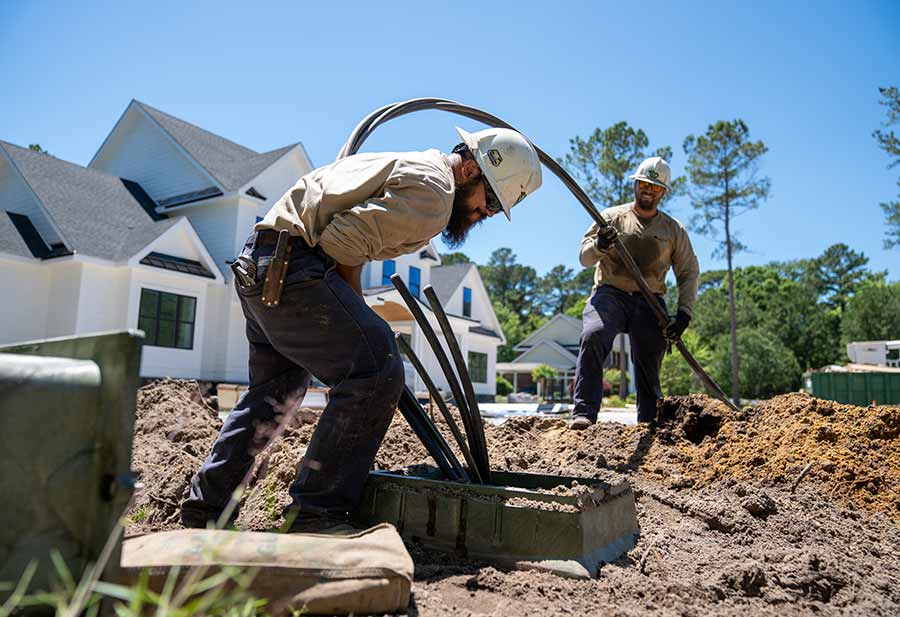Balancing the Advantages of Underground Power Lines: Reliability vs. Cost

Utility companies deliver electricity to homes via overhead or underground power lines, and each method offers customers advantages and disadvantages. The decision to use one over the other often depends on several factors, including cost, location, and reliability.
Introducing Underground Power Lines to Overhead Systems
Burying underground power lines dates back to the 19th century but didn’t gain significant momentum until the mid-20th century. The practice started to grow in the 1950s and 1960s when urban development and suburban expansion created a need for more reliable and aesthetically pleasing solutions for safe power distribution.
Santee Cooper powers over 6,500 miles of primary, secondary, and service distribution lines. Of those, 4,227 miles are underground power lines (64%), while 2,376 miles are overhead. Secondary and service lines are the lower voltage (120/240 volts) lines that connect to a customer’s home or business.
Most of the cities and towns Santee Cooper services feature significant portions of power lines installed underground. For example, 66% of the lines in the city of Myrtle Beach are underground. Within the City of Myrtle Beach, the Market Common area is 92% underground. The unincorporated Carolina Forest area is 89% underground. The town of Pawleys Island has 100% underground distribution lines.
Santee Cooper has been installing underground lines in new subdivisions for over 30 years and has franchise agreements with each city specifying that nearly all new lines will be installed underground.
The Expense of Underground Power Lines
To help offset the added costs of installing power lines underground, Santee Cooper has a 50/50 cost-sharing partnership with the municipalities for converting overhead lines. With new subdivisions, developers pay the difference between standard service (overhead) and premium service (underground). Based on revenue credits and developer performance, developers may be eligible for a refund of that payment.
Despite significant investments in underground lines, Santee Cooper still maintains the lowest electricity rates in South Carolina, a testament to our operational efficiency.
Reliability of Underground and Overhead Power Lines
Each distribution system faces unique challenges, and neither is without its imperfections. Trees can break from hurricane winds and down overhead power lines, causing outages and damage. Similarly, storm surges from hurricanes can lead to failures in the equipment that supports underground systems. Still, the advantages of underground power lines, from aesthetics to reduced outages from wind, critters, and damaging weather, continue to keep Santee Cooper a preferred utility provider.
It’s important to note that underground cables are not immune to failure over time. We mitigate this by installing power lines in conduit to simplify replacing failed sections. While underground power lines offer many advantages, repairs to the pad-mounted equipment supporting these systems can take significantly longer than repairing typical overhead failures.
At Santee Cooper, we pride ourselves on best-in-class reliability, consistently ranking in the top 10, or top 2%, of utilities nationwide. One key factor contributing to our success has been the implementation of these newer underground facilities.
The Future of South Carolina Power Distribution Systems
Santee Cooper will continue to install new lines underground within each city in keeping with the franchise agreements. Any conversions of existing overhead lines to underground will be directed by each city using franchise funds. New subdivisions will continue to be installed underground, with developers paying a portion of that construction. Grid Resilience Grant Program dollars could fund additional underground conversion projects if we identify overhead areas with reliability issues or recovery needs.
The cities of Myrtle Beach and North Myrtle Beach currently have active conversion projects. Over the next couple of years, we’ll also activate conversion projects in Surfside and Conway.
There is no one-size-fits-all solution for any one city. When comparing the advantages of overhead and underground power lines, we consider geography, weather patterns, urban development, and available budget. For many communities, a combination of overhead and underground power lines provides the most advantages while balancing cost, reliability, and safety.
